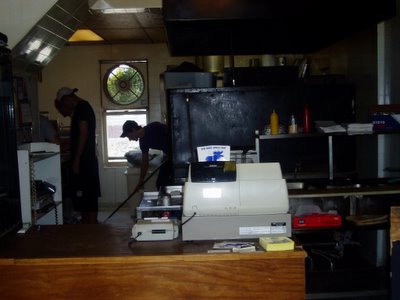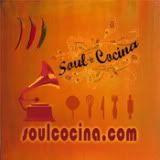Origionally posted in January of '06, this post has been updated with a musical soundtrack. It
It is was citrus season (a few monthw ago) in California so we headed down to the Alemany Farmers Market in San Francisco to pick out some oranges for our marmelade.
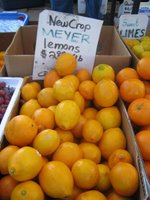 -It is hard to make a decision with so much to choose from
-It is hard to make a decision with so much to choose from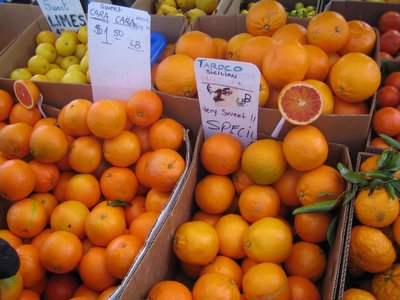 We chose a blend of oranges for a unique and personalized marmelade. (also because it is hard to choose just one variety) The Seville orange provided the classic bitter flavor, the Sicilian Tarocco Orange countered the bitterness of the Seville with its sweet juicy red tinted fruit, and the Cara Cara offered a unique, sweet grapefruit flavor to finish the blend. The Cara Cara originated at the Hacienda Cara Cara in Venezuela and was brought to Florida in the 1970's, now it also grows in the Californian San Joaqin Valley. The Seville orange does come from Seville but historians used to believe that it originated in China, now some say Northern India, some say South East Asia, and some even say it comes from Pacific islands like Guam, Samoa, and Fiji. Anyhow, we know for sure that the Moors brought the bitter Seville orange to Spain and Sicily where it grows very well as early as the 9th century. Seville was the center of Arabic culture in Al-Andalus (the Iberian penninsula, modern day Spain and Portugal) at the time and many trees were planted there.
We chose a blend of oranges for a unique and personalized marmelade. (also because it is hard to choose just one variety) The Seville orange provided the classic bitter flavor, the Sicilian Tarocco Orange countered the bitterness of the Seville with its sweet juicy red tinted fruit, and the Cara Cara offered a unique, sweet grapefruit flavor to finish the blend. The Cara Cara originated at the Hacienda Cara Cara in Venezuela and was brought to Florida in the 1970's, now it also grows in the Californian San Joaqin Valley. The Seville orange does come from Seville but historians used to believe that it originated in China, now some say Northern India, some say South East Asia, and some even say it comes from Pacific islands like Guam, Samoa, and Fiji. Anyhow, we know for sure that the Moors brought the bitter Seville orange to Spain and Sicily where it grows very well as early as the 9th century. Seville was the center of Arabic culture in Al-Andalus (the Iberian penninsula, modern day Spain and Portugal) at the time and many trees were planted there. 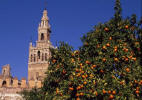
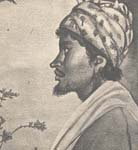 I bet it came to Spain with Ziryab. Ziryab was a freed slave from Bahgdad, which was also a cultural center of the Arab empire at the time. He studied with the most famoius musician of the day, Ishaq al-Mawsili, son of Ibrahem Al-Mawsili Ziryab's teacher beacame jealous and feared that his student was begining to grow more talented than the teacher so he chased Ziryab out of Bahgdad. Ziryab fled with his family and his specially designed lute to Tunisia, then across North Africa crossing the Straits of Gilbralter and landing in Algeciras, the birthplace of Spain's most celebrated guitarist, many centuries later, Paco de Lucia. Ziryab invented what we know today as the guitar. He had added a fifth string to the traditional four stringed lute and had designed a body with thinner wood to play his magical music on. Back in Baghdad when Ziryab was summuned to sing for the Caliph Harun Al-Rashid, the caliph was amazed and asked him to play some more songs on his master's lute. Ziryab respectfully declined the instrument. "I've brought my own lute," he said, "which I made myself—stripping the wood and working it—and no other instrument satisfies me. I left it at the palace gate and, with your permission, I'll send for it." Harun sent for the lute. He examined it. It looked like Ishaq al-Mawsuli's.
I bet it came to Spain with Ziryab. Ziryab was a freed slave from Bahgdad, which was also a cultural center of the Arab empire at the time. He studied with the most famoius musician of the day, Ishaq al-Mawsili, son of Ibrahem Al-Mawsili Ziryab's teacher beacame jealous and feared that his student was begining to grow more talented than the teacher so he chased Ziryab out of Bahgdad. Ziryab fled with his family and his specially designed lute to Tunisia, then across North Africa crossing the Straits of Gilbralter and landing in Algeciras, the birthplace of Spain's most celebrated guitarist, many centuries later, Paco de Lucia. Ziryab invented what we know today as the guitar. He had added a fifth string to the traditional four stringed lute and had designed a body with thinner wood to play his magical music on. Back in Baghdad when Ziryab was summuned to sing for the Caliph Harun Al-Rashid, the caliph was amazed and asked him to play some more songs on his master's lute. Ziryab respectfully declined the instrument. "I've brought my own lute," he said, "which I made myself—stripping the wood and working it—and no other instrument satisfies me. I left it at the palace gate and, with your permission, I'll send for it." Harun sent for the lute. He examined it. It looked like Ishaq al-Mawsuli's.
"Why won't you play your master's lute?" the caliph asked.
"If the caliph wants me to sing in my master's style, I'll use his lute. But to sing in my own style, I need this instrument."
"They look alike to me," Harun said.
"At first glance, yes," said Ziryab, "but even though the wood and the size are the same, the weight is not. My lute weighs about a third less than Ishaq's, and my strings are made of silk that has not been spun with hot water—which weakens them. The bass and third strings are made of lion gut, which is softer and more sonorous than that of any other animal. These strings are stronger than any others, and they can better withstand the striking of the pick." Ziryab didn't use a plain wooden pick like the other musicians, he used an eagle claw. Apon arrival in Spain with his guitar, Ziryab was hired by the Caliph of Cordoba in southern Spain, Abd al-Rahman to promote culture in the region. Ziryab was granted a palace and villas along with a salary of gold and wheat. The caliph wanted to bring refinement to the region which was once the wild west of the Arabic empire and at that time on the verge of a renaissance. It had been under Arab rule since 711 and was previously ruled by the barbaric Goths and previously the vicious Vandals. Unlike other European cities of the time, Cordoba had paved streets and streetlamps. There were fountains and gardens, bath houses, many beautiful mosques and street musicians. Abd al-Rahman wanted Cordoba of Al-andalus to be a cultural center to rival Bahgdad and Demascus. The caliph's views on arts and culture contributing to society are echoed today in the words of Govind Swarup, Principal Secretary of Cultural Affairs, Maharashtra, India, “Fine arts is not only a matter of self satisfaction or entertainment. It is also a major instrument for influencing the personality and inculcating values that are good for the individual as well as for the society. A sensitivity that is very much needed today comes only through fine arts" In Al-andalus Ziryab also became a minister of culture. He became a strategist for the region and an arbiter of fashion and taste, and a poet. He was granted money to start a music school which flurished for 500 years. Besides music he also had an interest in cuisine. Since the Roman empire food was piled up on bare wooden tables all together at one time. Ziryab changed all that with the introduction of course service and elegant and artistic plate and banquet presentation. He also introduced fine tableclothes and plate and glassware. He brought many recipes and dishes from Bahgdad and created many original dishes. One dish was meatballs and small triangular pieces of dough fried in coriander oil, came to be known as taqliyat Ziryab, or Ziryab's fried dish. He was also a great pastry chef. He invented the zalabia, fried dough soaked in orange flavored syrup. In India Ziryab's zalabia is called jalebi.  You can see jalebis being made in the opening scenes of Heeraz Marfatia'a modern classic filmBirju. Jalebis are cousins of the rounder and fatter gulab jamuns we posted a few weeks ago. Ziryab was also the first to bring asparagus to the table. Ziryab also opened a beuty parlor/cosmetology school and invented funky haircuts. He became a fashion designer and imported fancy silk from India. As well as ideas from Bahgdad he also borrowed from Indian culture. He had Indians teach chess to the people of Al-Andalus and brought astrologers from India too.
You can see jalebis being made in the opening scenes of Heeraz Marfatia'a modern classic filmBirju. Jalebis are cousins of the rounder and fatter gulab jamuns we posted a few weeks ago. Ziryab was also the first to bring asparagus to the table. Ziryab also opened a beuty parlor/cosmetology school and invented funky haircuts. He became a fashion designer and imported fancy silk from India. As well as ideas from Bahgdad he also borrowed from Indian culture. He had Indians teach chess to the people of Al-Andalus and brought astrologers from India too.
So if Ziryab didn't bring the sour orange trees to Spain it surely must have been someone that he knew. He became powerful and influential even in political decision making in Al-Andalus.
Federico Garcia Lorca was another renaissance man of Andalucia. Garcia Lorca is amous for his plays and poetry about life in Andalucia, but he was also an artist and musician. He staged travellling roadshows for the villages of southern Spain, entertaining and educating the people through puppet shows, musicals, and story telling. He was a progressive free thinker and used creativity for personal and comunal growth and advancement.
Here is the flamenco guitar virtuoso Paco de Lucia at the young age of 17 performing one of many songs written by Garcia Lorca.
Tune: Las Tres Hojas performed by Paco de Lucia, and written by Federico Garcia Lorca.
Here is Paco a few yars later with the young Camarón de la Isla, one of the world's greatest singers of all time.
Tune: Te Vas a Conseguir Tres Cosas by Camarón de la Isla con Paco de Lucia
Tune: Anta Oumri by Lole y Manuel This is a beautiful version of this classic Arabic song written by Egyptian star Mohamed Abdel Waheb done by the flamenco duo who brought a touch of psychedelia to gypsy music in the 1970s and 80s. Their rhythm and duende is magical.
Tune: Tierra que Canta also by Lole y Manuel is a great example of how Andalusian music changes with the times while keeping its roots. Listen to the electric guitar as it zaps its way into this flamenco song with grace.
Tune: Romero Verde is a classic tune by Lole y Manuel in a true Andalusian Gypsy style.
Tune: Al Quivira is another example of Lole y Manuel's flamenco music with Arabic influences.
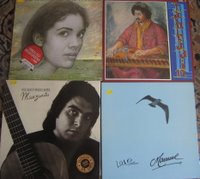
Tune: Turco Moro by Jalaleddin Takesh, another Bay area artist. This song brings together the Gypsy flamenco guitar of Andalucia and the Gypsy Kanoon of Persia.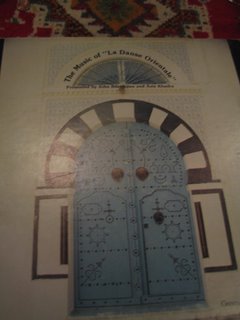
Tune: Sueños de Cadiz by John Bilezikjian and Aziz Khadra presents the flipside of the Lole y Manuel formula again with masters of Persian and Arabic music playing a Flamenco influenced song written by oud maestro Bilezikjian.
Check out more orange songs and orange topics over at Locust St.
Sir Walter Raleigh took sour orange seeds to England; they were planted in Surrey and the trees began bearing regular crops in 1595, but were killed by cold in 1739. The British love the sour oranges for making marmelade and perfumes. It's a good thing that the orange trees didn't survive in England because the shipping process actually helps make better marmelade. A combination of the exposure to the salted sea water environment and the banging together in the wooden barrels help to tenderize the oranges as they travel by sea to Great Britain in the first step of marmelade production. The sour Seville oranges we bought grow right here in California so we have to blanch the skin a few times in boiling water to tenderize which also helps remove a little bit of astringent flavor too. In Seville, people don't even use the sour oranges that line the streets. They are picked by one family that has owned the orange trees of Seville for generations and are shipped to the UK for marmelade and perfume. But Sevillanos and visitors to Seville do get to enjoy the wonderful fragrance provided by the trees all over the city.
- Citrus season also means allergy season. Some people say that local honey helps with allergies. There are a few theories about local honey and it's benefits. There is even a brew that aids hayfever in England that is made from honey. We buy local produce whenever possible to support local farmers, cut down on transportation pollution and oil dependancy, and to promote regional cuisine with regional ingredients. We bought some local honey to use instead of sugar in our marmelade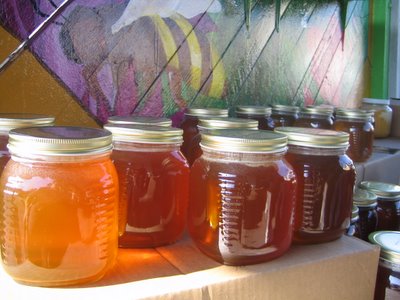 MP3: Her Comes the Honeyman from Porgy and Bess, sung by Ray Charles.
MP3: Her Comes the Honeyman from Porgy and Bess, sung by Ray Charles.
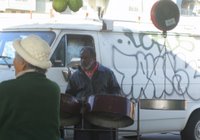 After all the citrus and honey adventures we decide to chill out in the shade and check out some of the street musicians. The steel drum guy was super funky and the lady with the electric washboard guitar also opperated a dancing wooden puppet with her foot.
After all the citrus and honey adventures we decide to chill out in the shade and check out some of the street musicians. The steel drum guy was super funky and the lady with the electric washboard guitar also opperated a dancing wooden puppet with her foot.  The puppet contraption is just like the footdella that Jesse Fuller used to play his San Francisco blues back in the 50's (I wonder if the "Lone Cat" ever played at the Alemany Market?) The washboard-puppet-guitar lady played a great version of "Dinah" that sounded like something she learned back in 1911. She had all the toddlers' attention, and mine too. I hadn't heard the washboard and guitar compliment each other so well since I dusted off my favorite Big Bill Broonzy and Washboard Sam record,
The puppet contraption is just like the footdella that Jesse Fuller used to play his San Francisco blues back in the 50's (I wonder if the "Lone Cat" ever played at the Alemany Market?) The washboard-puppet-guitar lady played a great version of "Dinah" that sounded like something she learned back in 1911. She had all the toddlers' attention, and mine too. I hadn't heard the washboard and guitar compliment each other so well since I dusted off my favorite Big Bill Broonzy and Washboard Sam record, 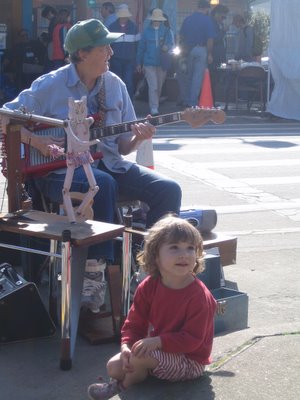
Tune: Diggin' My Potatoes by Washboard Sam and Big Bill Broonzy
Tune: Mamma Don't Allow by Washboard Sam
Tune: Old Yazoo by The Washboard Rhythm Kings "If you don't like rice and beans, have some beans and rice"
After our musical break we came across the egg and poultry section of the market. They were selling live quail, chickens, partridge, and rabbit. I'm not sure if the rabbits were being sold as pets or for food. I guess it is up to the customer what they do with the animals. I was also unclear about the use of a certain type of egg they were selling called balut. I decided I wanted to have scrambled duck eggs for brunch so I pointed to the Balut egg, asked for two, and handed the lady $1.10. Since they cost 55 cents each I naively thought they were some fancy variety of duck egg. But the lady explained to me that balut eggs are actually fertilised eggs that are meant to be boiled and eaten. This Philipino delicacy seemed a little hard core for brunch, maybe next Saturday I'll buy some for dinner.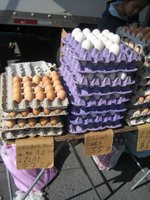
 Anyhow, we bought some regular duck eggs for our brunch and had a good meal before we started our marmelade production.
Anyhow, we bought some regular duck eggs for our brunch and had a good meal before we started our marmelade production.
-Veggies left over from Nori and Desi's sushi mise en place were great in our scrambled duck eggs. And the left over gyoza filling made great lil' brunch sausages.
Tune: A Huevo from El Chiapaneco Mix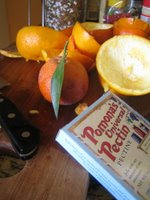
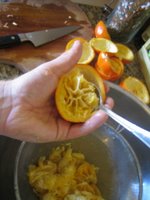

Chocolate sucre shell filled with blood orange curd, milk chocolate mousse, and a potent earl grey tea whip cream. Orange you glad it's tea time? The Tarts were photographed 2005 in the pastry kitchen of Citizen Cake. I also did a similar tart with burnt orange pastry cream and earl grey milk chocolate pot de creme... then there was the "Venezuela Vacation" tart which featured cara cara orange, El Rey white chocolate and tonka beans, or maybe it was called the Venezuela Sunset. So many different pastries every week, I loose track. I have most of the plated dessert menus I have created over the years, but all the other creations are sketched out in random notebooks and in the deep corners of my memory along with song lyrics, melodies, flavors, visions, dreams.... Anyhow, orange and tea and chocolate make for a glorious ménage à trois.
The Tarts were photographed 2005 in the pastry kitchen of Citizen Cake. I also did a similar tart with burnt orange pastry cream and earl grey milk chocolate pot de creme... then there was the "Venezuela Vacation" tart which featured cara cara orange, El Rey white chocolate and tonka beans, or maybe it was called the Venezuela Sunset. So many different pastries every week, I loose track. I have most of the plated dessert menus I have created over the years, but all the other creations are sketched out in random notebooks and in the deep corners of my memory along with song lyrics, melodies, flavors, visions, dreams.... Anyhow, orange and tea and chocolate make for a glorious ménage à trois.
The pastry cook in the photo behind the tarts is Luis V, a key member of the Tooth Decay Posse.
Tune: Bakershop Boogie by Willie Nix from Sun Records The Blues Years 1950-1958 (Disc 3)
The milk chocolate in the tarts comes from El Rey Venezuelan Chocolate. El Rey has over 75 years experience. They opened in Venezuela in 1929. They use only locally grown, high quality ingredients. All El Rey chocolates are made exclusively with a blend of Venezuelan beans from plantations south of Caracas, giving El Rey chocolate a unique flavor. Their white chocolate is also very good. It is one of the few white chocolates that is made only with non-deodorized cacao butter (deodorization is a chemical process that strips flavor) and it actually tastes like chocolate rather than just sugar, like most white chocolates. The dark chocolate used in the tart is from Scharffen Berger.
This is a pretty decent list of good quality chocolate from around the world. One of my favorites is Bonnat, a family business from France that dates back to 1884. They started producing dark chocolate bars from specific countries (Venezuela and Madagasgar) in 1902 and they were the first company to produce vintage chocolate, using beans from a specific plantation in 1994 with their unique Hacienda el Rosario bar.
Earl grey tea is a blend of black tea with dried bergamot zest and bergamot oils. When steeped in cream, earl grey tea pairs well with different chocolate flavors.
Oranges at the Alameny Farmers Market in San Francisco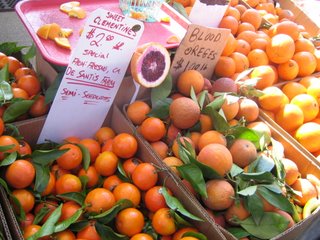
Thursday, July 20, 2006
La Naranja
Sunday, July 16, 2006
Salty, Sour, Spicy, Crunchy Go-Go
 Green papaya
Green papaya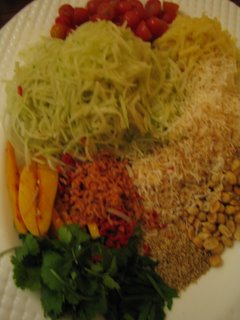
Green mango salad, green papaya salad, and green tea salad (lephet thoke, made with Burmese fermented green tea leaves) have inspired this vibrant, tastey, salty, sour, spicy, and crunchy creation. 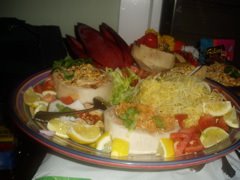 Green papaya, shredded (julienne cut or grated w/ box grater)
Green papaya, shredded (julienne cut or grated w/ box grater)
Green mango, shredded
Fermented green tea leaves (Lephet)*
Young ginger, shredded
Roasted peanuts
Toasted sesame seeds
Fried garlic slices
Yellow dal, soaked overnight, dried and fried
Cilantro
Thai chiles, finely diced
Toasted coconut
Cherry tomatoes, sliced in half
Dried shrimp, small
Cabbage, shredded
Dressing:
Lemon and Lime juice
Fish sauce
Soy sauce
Rice wine vinegar
Peanut oil
Mustard seeds, ground
Quantities of all the ingredients are based on personal taste.
Make mounds of each individual ingredient next to one another on a platter.
Just before serving, combine all the dressing ingredients and pour over all ingredients and mix together.
*Lephet, Burmese fermented tea leaf is hard to find. I use good quality green tea and combine with lemon juice and fish sauce in a mortar and pestle
For a Thai inspired meal serve with pla-dook foo.
In Cambodia, Papaya salad is served with salted crab.
In Isan, the Northeastern region of Thailand, papaya salad is served with pla rah a pickled mudfish with an oder as fierce as durian.
Here is a recipe for Som Tam Isan (papaya salad from Isan) Papaya salad ingredients at Wat Mongkolratanaram, Berkeley’s Thai Buddhist temple, where they serve affordable, homestyle Thai food to the public every Sunday
Papaya salad ingredients at Wat Mongkolratanaram, Berkeley’s Thai Buddhist temple, where they serve affordable, homestyle Thai food to the public every Sunday
Even Thai traditions are fading away with the globalized new world.
But I don't think McDonalds big macs will replace Thai street snacks, and neither Coke nor Starbucks can compete with Thai drinks
Tune: Kotmorn Yoop Yap by Sakarin Boonpit off of Thai Beat A Go-Go Vol. 2 from Subliminal Sounds records is a whacky version of All Shook Up!
Tune: Tee Makhuea Pok is another Thai cover of an American song. This time the artist goes even more country with a version of You're Cheatin' Heart. The artist is Pairote, also on Thai Beat a Go-Go.
Tune: Wasana Gam Par (Could You Love Me?) by Chaan Siang Phin off the cd Molam: Thai Country Groove from Isan from Sublime Frequencies records is a real scorcher. Nice groove.
Download more Asian Pop Oldies
The cuisine of Isan, in the Northeast corner of Thailand, is different from the rest of the nations cuisine because they do not use as much coconut milk. The food is extra spicey in Isan with lots of chillies and herbs. They eat a lot of stickey rice and the cuisine shares many traditions and recipes with neighboring Laos.
Friday, July 14, 2006
Maamoul
I was thrilled to find a recipe for Maamoul when browsing through a Lebanese cookbook at Green Apple Bookstore in the Richmond District in San Francisco. I was trying to find a use for the leftover walnut date filling I had from the strudel I made a few days ago when I came across this recipe that also gave me the opportunity to utilize the wooden butterfly mold I bought in Chinatown a few months ago. Maamoul is traditionally made by the whole family during Easter in Lebanon. Date maamoul is supposed to be made in a specially shaped mold, but walnut maamoul can be made in any kind of mold. I think the butterfly mold goes well with the coming of Spring and the end of the rain here in SF. Let the sun shine!
Tune: Sunshine by Mos Def from The New Danger
Tune: Sun Comes Up by John Legend
Tune: Devil's Pie (Paul Nice remix) by another modern soul singer D'Angelo over a summertime Tribe Called Quest beat from the Bay Area's own DJ's J Boogie and Sake One's latest mix tape Leftism Pick it up at Fabric8 To fill the maamoul with the walnut date filling you are supposed to roll the semolina dough into balls and then make a well in the ball with your thumb, fill the well and close it back up. Then you are supposed to press the dough into the molds. I fill the molds half way with the dough then add the filling and then top it off and seal it with more dough. I found this easier to do with the intricate molds that I was dealing with.
To fill the maamoul with the walnut date filling you are supposed to roll the semolina dough into balls and then make a well in the ball with your thumb, fill the well and close it back up. Then you are supposed to press the dough into the molds. I fill the molds half way with the dough then add the filling and then top it off and seal it with more dough. I found this easier to do with the intricate molds that I was dealing with. They are baked for only 10-12 minutes at 300 degrees F. The dough is just semolina, butter, a tiny bit of sugar, salt water, and flavor. The recipe calls for rose water and orange blossom water in the dough. I used saffron rose water, a great Middle Eastern and Persian flavor combination that is also a favorite of Elizabeth Falkner and is perfect for a breezy and sunny afternoon tea time.
They are baked for only 10-12 minutes at 300 degrees F. The dough is just semolina, butter, a tiny bit of sugar, salt water, and flavor. The recipe calls for rose water and orange blossom water in the dough. I used saffron rose water, a great Middle Eastern and Persian flavor combination that is also a favorite of Elizabeth Falkner and is perfect for a breezy and sunny afternoon tea time.
Tune: Maktoubik Malyan by Lebanese pop star Wael Kfouri
French Labanese RapperClotaire K infuses nice Arabic melodies and instruments into his beats.
Tune: Laisse Les by Clotaire K
Tune: Maqam by Clotaire K
Arabic influenced beats by the Bay's own J. Boogie
Tune: Ritual of The Nile by J Boogie off his Dubtronic Science record
Tune: Dance of Ayten by another Bay Area artist, Jaleleddin Takesh who owns Pasha , a Persian restaurant in San Francisco with live music and belly dancing. Jalaleddin plays the kanoon which is popular in Turkish Gypsy music. Jalaleddin was also in a Hawaii 5-0 episode in 1978. Dance of Ayten is a short Belly Dance piece with a few sudden shifts in tempo and features violin and kanoon solos.
Our friends at Global Phatness Radio have been providing us with a great internet radio station for a minute now that is full of Arabic beats and traditional tunes and mas. There first CD Suryaghati is a modern classic.
Tune: Surya (sun) by San Francisco based Global Phatness feat. Hafez Modir
East meets West again with a another wicked mash up by The Boston Jerk. This next track is another study in sound and culture. Get schooled at The Riddim Method or at Wayne and Wax. He has some great observations, commentaries, and philosophies on pop culture and music. Check out his dancehall and reggaeton posts.
Tune: Big-Gyptian mix where he once again mashes and blends some classics with some classics. Jay-Z meets Abdel-Halim Hafez.
Tune: Guazz Aldam (Blood Wedding) by Egyptian rapper MC Pharosan
Tune: Celia in Cairo This track is from a bootleg CD I bought on the streets of Tangier, Morocco.
Tune: Nice Arabic Joint Another track from a Moroccan street CD.
Tune: Missy in Morocco A mash up by DJ Crow, another cut from the streets of Morocco.
Tune: Moroccan Street Jam A more traditional jam, but still popular with the youth.
Tune: Moroccan Street Jam with heavy duty MC
Tune: Calling All Absentees by Kid Gusto of True Grooves, Washington DC gives a middle eastern percussion touch to a rolling reggae stomper.
Tune: 3 Bandits by Bumcello from Nude For Love big Middle Eastern feel on this groove with hip hop beat
Tune: Beautiful You also by Bumcello also from Nude For Love This track does not have much Middle Eastern sounds but it features the Bay's own Gift of Gab and Lateef the Truth Speaker.
Tune: Ya Binaya Goumi (Oh Girl, Stand Up) by Bawin from Choubi Choubi: Folk and Pop Sounds from Iraq
Say Cheese!
-Paneer hanging to drain, Crawford Market, Mumbai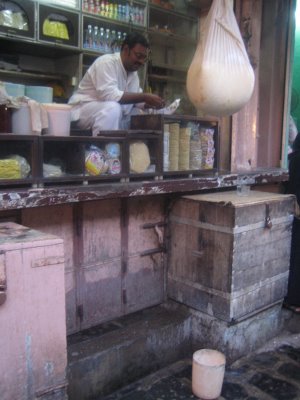 Paneer is India's cottage cheese made from heating milk with a little acid, usually lemon juice or vinegar to seperate the curd from the whey. Then the curd is hung to extract more whey, it is also sometimes pressed to make it more condensed and solid so it can be cut into cubes and used in savory dishes like saag paneer (spiced spinach w/ paneer). Paneer is one of the holy milk preparations of India used to make sweets to offer to the gods or to enjoy at festivals, or for sweets to be served simply with tea.
Paneer is India's cottage cheese made from heating milk with a little acid, usually lemon juice or vinegar to seperate the curd from the whey. Then the curd is hung to extract more whey, it is also sometimes pressed to make it more condensed and solid so it can be cut into cubes and used in savory dishes like saag paneer (spiced spinach w/ paneer). Paneer is one of the holy milk preparations of India used to make sweets to offer to the gods or to enjoy at festivals, or for sweets to be served simply with tea.
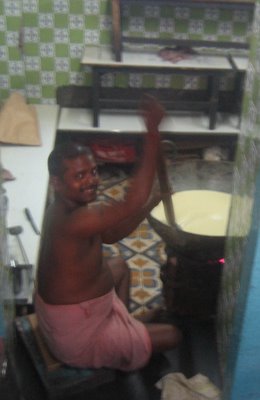 -Milk reducing over a wood fire to make Koya next to Mahalaksmi Temple, Mumbai
-Milk reducing over a wood fire to make Koya next to Mahalaksmi Temple, Mumbai
Tune: Calling All Cows by the Blues Rockers from the Excello Records vault
 Desi and friend contemplate some Italian cuisine at a tourist restaurant in Goa while a cow enters a puppet workshop in Rajasthanon, below.
Desi and friend contemplate some Italian cuisine at a tourist restaurant in Goa while a cow enters a puppet workshop in Rajasthanon, below.
.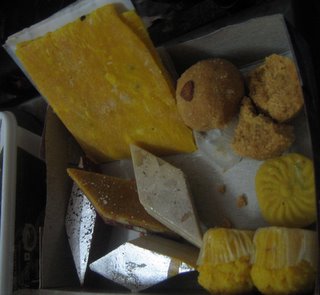

Sweets made from milk
-above, malai kheer (sweet milk simmered with saffron and cardamom) at Heeraz and Shubhra's wedding in Ajmer.
-left, barfi and other milk sweets from one of Mumbai's many sweet shops.
-Here is one of my versions of an Indian milk based dessert, "The Taj Mahal", Elephant heart plum kulfi is topped with a saffron Italian merengue bringing together the flavors of masala kulfi w/ the idea of baked Alaska 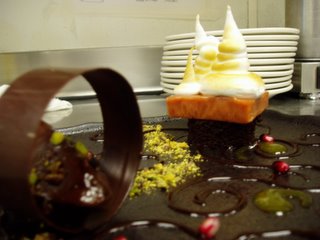


This is the "Mumbai Bazaar", gajar ka halwa wrapped in a crisp, sweet urad daal tuile (the stripes are from black daal and white daal, hulled and w/ it's black skin), topped w/ saffron foam, served w/ black urad daal gelato over cardamom- jaggery puffed rice (murmura) candy and a pandaan (screw pine) sauce.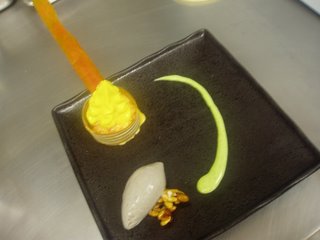
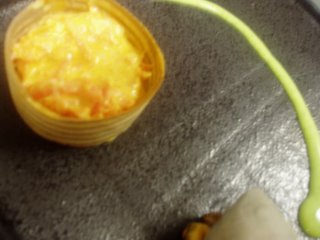
 Check out these desserts.
Check out these desserts.
Gulab Jamun, fried dough balls made from a mix of koya and paneer then saoked in a flavored syrup, usually rose, cardamom, and/or saffron Although the old school method of making gulab jamun is still popular, there are many premade mixes and maida (self rising flour) and milk powder is often substituted for the more labor intensive processes of traditional paneer and koya that require the care and patience appreciated by the slow food movement.
Although the old school method of making gulab jamun is still popular, there are many premade mixes and maida (self rising flour) and milk powder is often substituted for the more labor intensive processes of traditional paneer and koya that require the care and patience appreciated by the slow food movement.
There are many fried dough snacks served all around the globe. Gulab Jamun is unique in the fact that the dough is made with cheese. Some Italian pastries use fried dough and cheese, like cannoli. The Roman, rags to riches politico Marcus Cato has a recipe for milk dough fritters soaked in honey (called globi) which have a very close resemblence to Gulab Jamun in his manuel On Farming. Written in 170 B.C., On Farming is the first surviving work of latin prose and features the recipe in entry #79, halfway through the manuel: "Globi to be made thus: mix cheese and emmer.... ; make as many balls as you want. Put fat in a hot bronze pan: cook one or two at a time, turning them frequently with two sticks. When cooked remove them, coat in honey, roll in poppy-seeds, serve. "
I like how they used to roll the sweets in poppy seeds after soaking in homey. But, sadly this tradition has faded away and these poppy seed coated sweets are no longer popular. Roman globi have evolved into the Italian Sfingi and the Zeppele. They have many variations and although they are traditionally made from a ricotta cheese dough, some are made from choux paste or yeast doughs. Many are still soaked in a flavored sugar syrup like their cousins gulad jamun and their grandmother globi, but the flavor is usually citrus zest, cinnamon or vanilla. Although some are simply rolled in granulated sugar like a donut. San Guiseppe (St Joeseph's Day, March 19thy) is the day for zeppole in Italy, especially Naples, where friggitorie (fried food stalls) and pasticcerias (pastry shops) serve Zeppoles by the millions. 
 Italian bakeries in Chicago start advertising in February.
Italian bakeries in Chicago start advertising in February.
-Il giardino on Harlem Ave in Chicago
If you happen to be in Paris on the Prarie picking up some Zeppeli for St. Joseph's Day, you should probably pick up a Chicago style hot dog anywhere you see a sign like this below: -just make sure you don't ask for ketchup on your hot dog
-just make sure you don't ask for ketchup on your hot dog
Tune:No More Hot Dogs by the wild man, outsider hillbilly punk, Hasil Adkins
Tune: I'm a Little Weenie by the Windy City legend with a Chitown figure, Dick "Two Ton" Baker ("The Music Maker of Chicago")
If you are in Chitown and you are really hungry and a dog won't cut the mustard, then head over to Maxwell St (actually S. Union Street, next to the Dan Ryan just off of Roosevelt Rd) and fork over $2.50 for a Maxwell Street Polish Sausage at Jim's Grill, home of the original Maxwell St Polish Sausage invented in 1910 by an immigrant from Yugoslavia in 1914. Up until the early 90's Jim's was in a historic pre-Chicago fire building on the corner of Halsted and Maxwell St. The maxwell Street market that flourished back in the day was the birthplaace of Chicago Blues and urban electric blues. Many African American's from Mississippi, Louisiana, and other southern states migrated to Chicago from rural areas to escape the world of Jim Crow and sharecropping to work in the steel mills and meat packing factories of Chicago. (I guess they never read Upton Sinclaire's The Jungle) They brought with them their rich culture of music and stories. Adapting to it's new environment the folk delta blues music plugged into the electricity of urban life. Muddy Waters, who once led a jug band in Mississippi and was well known for the stories that accompanied his acoustic guitar, had become famous in Chicago for combining the rich culture of the delta blues with the new sounds of the electric guitar. Muddy and countless other blues pioneers used to play as street musicians at Maxwell St. and in bar band in the area.  Muddy's pal Hound Dog Taylor, also from Mississippi, used to play electric slide guitar with a cheap amp cranked to distorted levels on a cheap guitar on Maxwell Street. His sound was so heavy that he makes these guys sound soft. Where did Hound Dog Taylor plug in? He used to have an extension cord that ran into Jim's Grill! He would plug in next to the kitchen sink. One Maxwell Street legend as told by Chicken Charlie, is that once the dishwasher at Jim's let the sink overflow while snacking on a Polish and the water dripped onto Hound Dog's guitar cord and gave him a mighty shock of a lifetime. This shock is said to be the inspiration behind Kitchen Sink Boogie. One of my favorite Hound Dog Taylor songs is 55th st Boogie. This is a real summertime scorcher. I loved this song when I first heard it as a kid when I lived right off of 55th street.
Muddy's pal Hound Dog Taylor, also from Mississippi, used to play electric slide guitar with a cheap amp cranked to distorted levels on a cheap guitar on Maxwell Street. His sound was so heavy that he makes these guys sound soft. Where did Hound Dog Taylor plug in? He used to have an extension cord that ran into Jim's Grill! He would plug in next to the kitchen sink. One Maxwell Street legend as told by Chicken Charlie, is that once the dishwasher at Jim's let the sink overflow while snacking on a Polish and the water dripped onto Hound Dog's guitar cord and gave him a mighty shock of a lifetime. This shock is said to be the inspiration behind Kitchen Sink Boogie. One of my favorite Hound Dog Taylor songs is 55th st Boogie. This is a real summertime scorcher. I loved this song when I first heard it as a kid when I lived right off of 55th street.
Tune: 55th Street Boogie by Hound Dog Taylor and the Houserockers
Tune: Kitchen Sink Boogie also by Hound Dog Taylor and the Houserockers
Tune: I'd Rather Drink Muddy Water by Chicago singer Billie McKenzie -Maxwell Street band 1968
-Maxwell Street band 1968 -Chicken Charlie, one of Maxwell Street's regular colorful characters
-Chicken Charlie, one of Maxwell Street's regular colorful characters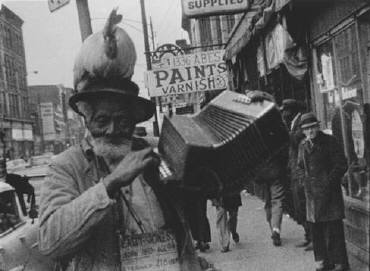
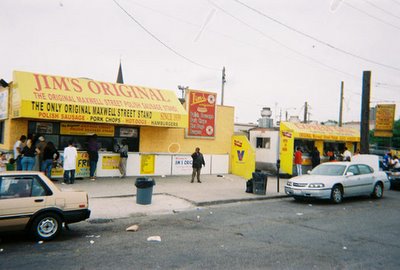 Some people prefer the Polish's at Express Grill, which was opened by a relative of the Jim's Grill family and also used to be on Maxwell St. Now they are right next to each other along the highway.
Some people prefer the Polish's at Express Grill, which was opened by a relative of the Jim's Grill family and also used to be on Maxwell St. Now they are right next to each other along the highway. Both of these places serve old school Maxwell St. Polish's just like Jim's did back in the roaring 20's with grilled onions and mustard.
Both of these places serve old school Maxwell St. Polish's just like Jim's did back in the roaring 20's with grilled onions and mustard. Only thing that has changed is the location. Sadly, the University of Illinois Chicago took over the area that once was home to Maxwell Street Market around 1994 in a deal with mayor Daley.
Only thing that has changed is the location. Sadly, the University of Illinois Chicago took over the area that once was home to Maxwell Street Market around 1994 in a deal with mayor Daley.
-Maxwell St circa 1963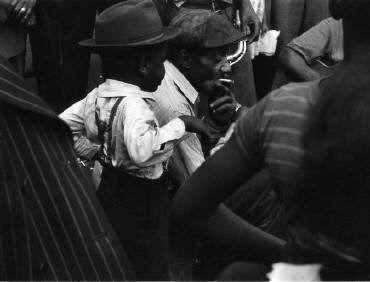 -Maxwell Street today
-Maxwell Street today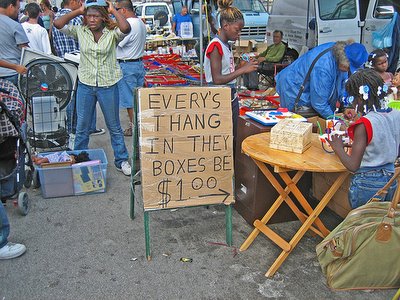

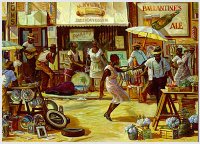


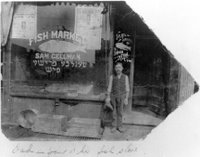 Maxwell Street neighborhood used to be called Jewtown, even by the blues musicians, because the market was founded in the mid 1870's by Eastern European Jews. Since then Maxwell Street has been a home and a meeting place for people from all over the world. The much smaller and compromised version of the market that survives today on the outskirts of the original location is a great place for authentic Mexican food, like zuchinni blossom quesadillas, octopus ceviche, and beef tongue tacos.
Maxwell Street neighborhood used to be called Jewtown, even by the blues musicians, because the market was founded in the mid 1870's by Eastern European Jews. Since then Maxwell Street has been a home and a meeting place for people from all over the world. The much smaller and compromised version of the market that survives today on the outskirts of the original location is a great place for authentic Mexican food, like zuchinni blossom quesadillas, octopus ceviche, and beef tongue tacos.
-This sign for a grocery store near Maxwell St. shows that there are shoppers from all cultures who can still find what they want in this uniquely diverse city If you are not up for a Maxwell Street Polish or a tongue taco, you can always find an Italian beef sandwich, downtown, northside, southsibe, westside, or the 'burbs.
If you are not up for a Maxwell Street Polish or a tongue taco, you can always find an Italian beef sandwich, downtown, northside, southsibe, westside, or the 'burbs.
Des enjoys a beef from Buona Beef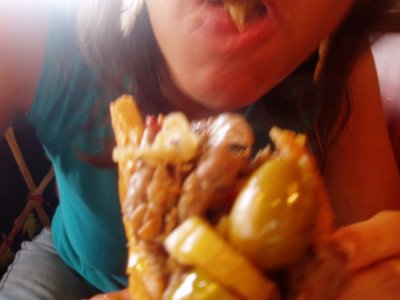 BuonaBeef is not the usual ma and pa kinda place I like to recommend, but it sure is goooood!
BuonaBeef is not the usual ma and pa kinda place I like to recommend, but it sure is goooood!
-Beef w/ giardinare to go
The best Pizza in the world is thin crust and is cut in squares, and the best place for real Chicago pie is the Spaghetti Bowl of Western Springs. This is not tourist deep dish, eat once every two months, spend $30 pizza. This is real Chitown pie. Eat it four to five times a week and still keep that great Chicago figure. Well, the bowl is leaving it's historical home at 808 Hillgrove. But it is keeping what counts. The ovens. Temporary home to some of the culinary arts greatest offerings to mankind, these ovens have seen enough cornmeal to fill the Grand Canyon. Leave em on overnight and the next day's pies are golden crisp love letters.
-here is the original Bowl next to its new home. But the old wise man that sits under the WS Watertower says, "You can take the ovens out of the historical landmark, but you can't take the love and flavor out of the pie." -Here I have an important meeting with the Bowl's top dog Timmy C discussing the importance of modern food trends, the integrity of traditional pizza making, and the future of Chicago's greatest pizzaria.
-Here I have an important meeting with the Bowl's top dog Timmy C discussing the importance of modern food trends, the integrity of traditional pizza making, and the future of Chicago's greatest pizzaria.
-The Bowl's Pizzailo's hard at work. Temperature? ...175 degrees F